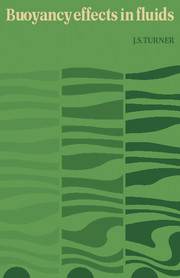Book contents
- Frontmatter
- Contents
- Preface
- 1 INTRODUCTION AND PRELIMINARIES
- 2 LINEAR INTERNAL WAVES
- 3 FINITE AMPLITUDE MOTIONS IN STABLY STRATIFIED FLUIDS
- 4 INSTABILITY AND THE PRODUCTION OF TURBULENCE
- 5 TURBULENT SHEAR FLOWS IN A STRATIFIED FLUID
- 6 BUOYANT CONVECTION FROM ISOLATED SOURCES
- 7 CONVECTION FROM HEATED SURFACES
- 8 DOUBLE-DIFFUSIVE CONVECTION
- 9 MIXING ACROSS DENSITY INTERFACES
- 10 INTERNAL MIXING PROCESSES
- Bibliography and Author Index
- Recent Publications
- Subject Index
- Plate section
4 - INSTABILITY AND THE PRODUCTION OF TURBULENCE
Published online by Cambridge University Press: 05 August 2012
- Frontmatter
- Contents
- Preface
- 1 INTRODUCTION AND PRELIMINARIES
- 2 LINEAR INTERNAL WAVES
- 3 FINITE AMPLITUDE MOTIONS IN STABLY STRATIFIED FLUIDS
- 4 INSTABILITY AND THE PRODUCTION OF TURBULENCE
- 5 TURBULENT SHEAR FLOWS IN A STRATIFIED FLUID
- 6 BUOYANT CONVECTION FROM ISOLATED SOURCES
- 7 CONVECTION FROM HEATED SURFACES
- 8 DOUBLE-DIFFUSIVE CONVECTION
- 9 MIXING ACROSS DENSITY INTERFACES
- 10 INTERNAL MIXING PROCESSES
- Bibliography and Author Index
- Recent Publications
- Subject Index
- Plate section
Summary
In this chapter we consider various mechanisms whereby laminar flows of a stably stratified fluid can break down and become turbulent. The first task is to summarize some results of hydrodynamic stability theory as it applies in this context, that is, the investigation of the conditions under which small disturbances to the motion can grow. The logical development of the preceding chapters will be followed by restricting the discussion to dynamic instabilities due to shearing motions of a statically stable initial stratification. ‘Convective’ instability associated with an increase of density with height will be left until chapter 7, and two-component systems, in which different diffusivities play a vital role, will be treated separately in chapter 8.
The problem of instability of layers across which both density and velocity are rapidly varying functions of height is given special attention here, since such shear layers are very common in the atmosphere and ocean, and the vertical transports of properties such as heat and salt depend strongly on what happens near them. The topics covered now will, however, go beyond what is usually meant by the term ‘instability’ in the strict sense. It seems useful at the same time to outline other ways in which energy can be fed into limited regions of a more extensive flow, at a rate sufficient to cause a local breakdown. Some of the phenomena have already been mentioned in the context of steady flows, and the wider geophysical implications of the results will be discussed in chapter 10.
- Type
- Chapter
- Information
- Buoyancy Effects in Fluids , pp. 91 - 126Publisher: Cambridge University PressPrint publication year: 1973
- 3
- Cited by

